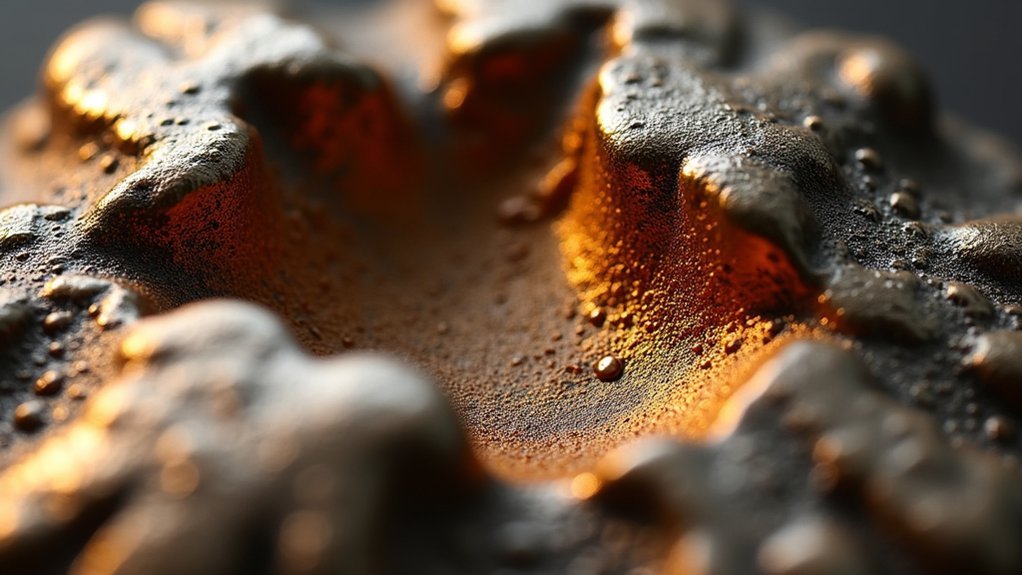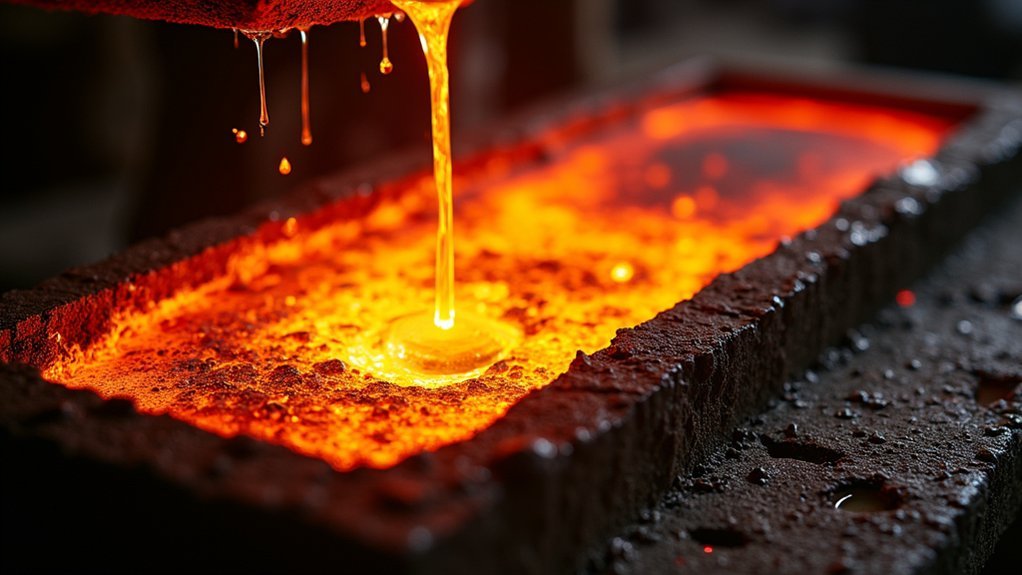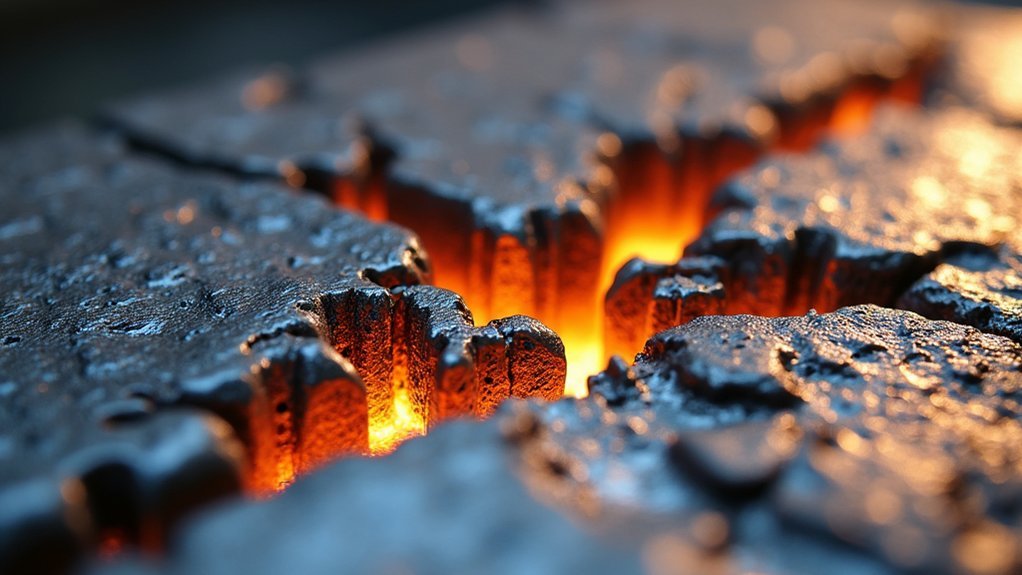You’ll encounter casting defects in metal pieces when gases become trapped during solidification, creating porosity and blowholes. Uneven cooling rates cause shrinkage cavities and dimensional distortions, while poor mold quality leads to surface irregularities and metal penetration. Improper pouring techniques introduce turbulence that traps air, and contaminated materials create inclusions. Temperature control issues during casting result in cold shuts and incomplete fills. Understanding these interconnected factors will help you identify the specific solutions needed for each casting challenge.
Understanding the Root Causes of Jewelry Casting Defects

When you’re crafting jewelry through casting, several critical defects can undermine your finished pieces before they even leave the mold.
Gas porosity creates the most common issues you’ll encounter, forming when trapped gases produce pinholes and blowholes that weaken your metal’s structure.
You’ll also face shrinkage defects that develop during cooling, creating internal voids as the metal contracts unevenly throughout solidification.
Inclusions present another significant challenge when foreign particles like sand or oxides embed themselves in your molten metal due to poor mold preparation.
Cold shuts occur when you don’t maintain adequate metal flow, resulting in visible seams that compromise both appearance and durability.
Understanding these root causes helps you identify where your casting process needs adjustment for consistently high-quality results.
Gas Entrapment and Porosity Formation During Metal Solidification
Gas entrapment strikes at the heart of your casting quality, occurring when dissolved gases in molten metal can’t escape before solidification traps them permanently within your piece. This creates various porosity types, including small pinholes and larger blowholes that form beneath the surface.
Gas entrapment occurs when dissolved gases become permanently trapped during solidification, creating destructive pinholes and blowholes in your castings.
You’ll encounter increased gas entrapment when moisture contaminates your molten metal or mold materials, generating steam bubbles during cooling.
Turbulent pouring techniques worsen the problem by trapping air through excessive agitation.
Blowholes pose particular risks since they’re often undetectable until machining reveals compromised structural integrity.
You can minimize gas porosity through proper gas flow control, using clean and dry materials, and optimizing your casting parameters.
These strategies guarantee you’ll achieve high-quality castings with minimal defects.
Temperature Control Issues That Lead to Shrinkage Problems

When you’re casting metal pieces, temperature control problems create some of the most challenging shrinkage defects you’ll encounter.
Uneven cooling patterns cause different sections of your casting to solidify at varying rates, leading to dimensional distortions and internal stress concentrations.
You must manage thermal gradients carefully throughout the cooling process, as improper heat distribution will result in both surface deformations and hidden structural weaknesses that compromise your final product’s integrity.
Uneven Cooling Patterns
As metal shifts from liquid to solid during casting, uneven cooling patterns create one of the most problematic defect categories you’ll encounter in your production process.
When different sections of your casting cool at varying rates, you’ll face uneven shrinkage that compromises structural integrity. Areas retaining liquid metal longer develop closed shrinkage defects, forming internal voids that weaken your final product.
Hot spots cooling rapidly create hard zones that’ll complicate your machining operations and introduce stress concentrations. Without proper thermal management, differential temperature gradients cause warping, distorting your casting’s intended dimensions.
These cooling inconsistencies typically stem from inadequate feeder systems and poorly designed gating networks. You’ll need uniform heat distribution throughout the solidification process to prevent these costly defects.
Thermal Gradient Management
Effective thermal gradient management becomes critical because temperature control issues directly trigger the most damaging shrinkage problems in your castings.
When thermal gradients create differential cooling rates throughout your metal piece, you’ll face uneven shrinkage that produces both open and closed defects. Poor temperature control generates hot spots that cool faster than surrounding areas, causing internal cracks and hot tears.
Without uniform temperature distribution, shrinkage cavities form as hotter regions can’t feed properly during cooling. You must monitor cooling rates to prevent thermal stresses from uneven contraction, which leads to warping and dimensional inaccuracies.
- Optimize mold materials to enhance heat dissipation uniformity
- Design feeding systems that compensate for thermal gradient variations
- Implement controlled cooling sequences to minimize temperature differentials
Mold Quality and Material Defects in Jewelry Production
Since mold quality forms the foundation of successful jewelry casting, you’ll find that even minor deficiencies in mold materials can create significant defects in your finished pieces.
Poor mold integrity causes cuts, washes, and metal penetration that compromise your casting surface quality. When you don’t perform regular maintenance, erosion creates irregularities affecting both aesthetic appeal and structural integrity.
Poor mold maintenance creates surface defects and structural weaknesses that destroy both the beauty and integrity of your jewelry castings.
Contamination from previous castings introduces inclusions and surface blemishes into your jewelry. Insufficient mold strength leads to swells and drops where molten metal deforms the mold itself.
You can prevent these mold material defects by using high-quality materials, ensuring proper mold design with adequate venting, and maintaining consistent preparation standards for intricate jewelry designs.
Improper Metal Pouring Techniques and Their Consequences

When you pour molten metal incorrectly, you’ll create defects that compromise your casting’s structural integrity and surface quality.
Temperature control issues during pouring can cause cold shuts, misruns, and shrinkage defects that weaken the final product.
You’ll also face metal flow problems from turbulent pouring and inadequate gating systems, leading to gas porosity and incomplete mold filling.
Temperature Control Issues
Temperature control during metal pouring directly determines the quality of your final casting, as even minor deviations can trigger a cascade of defects that compromise both appearance and structural integrity.
When you pour metal at excessively high temperatures, you’ll create turbulence that traps gases, resulting in gas porosity defects throughout your casting. Conversely, insufficient heat causes cold shuts where metal streams don’t fuse properly, and misruns where your mold doesn’t fill completely.
Temperature discrepancies also generate hotspots that create closed shrinkage defects as your casting solidifies. These temperature control issues directly impact your casting’s structural soundness and surface finish.
- Monitor pour temperatures continuously to prevent cold flow and fusion problems
- Maintain ideal temperature ranges to avoid both turbulence-induced porosity and incomplete filling
- Control cooling rates to eliminate hotspot formation and shrinkage-related defects
Metal Flow Problems
Although temperature control sets the foundation for quality castings, your pouring technique determines how effectively that molten metal reaches every corner of your mold.
When you pour improperly, you’ll encounter metal flow problems that create serious defects in your castings.
Misruns occur when you don’t maintain adequate flow rates or temperatures, preventing complete mold filling.
Cold shuts develop when separate metal streams fail to fuse properly, creating weak points that’ll compromise your casting’s structural integrity.
Turbulent pouring traps gases, resulting in gas porosity defects like pinholes and blowholes throughout your piece.
Poor gating design compounds these issues by creating uneven flow patterns and localized shrinkage.
Additionally, low pouring temperatures cause cold shots, where metal splatters cool prematurely before properly embedding.
Moisture and Contamination Effects on Cast Metal Quality
Because moisture represents one of the most insidious threats to casting quality, you’ll find that even trace amounts can trigger a cascade of defects throughout your metal pieces.
When moisture contacts your tools or ingots, it releases hydrogen gas during melting, creating blisters and internal voids that severely weaken load-bearing capacity. Contamination from foreign particles like sand or oxide inclusions further compromises your casting’s integrity, reducing mechanical properties and overall quality.
Your poorly maintained molds accumulate contaminants that directly enter the casting process, causing surface defects and structural weaknesses.
- Gas porosity formation – Moisture creates hydrogen bubbles that become permanent voids in solidified metal
- Hydrogen embrittlement – Dissolved hydrogen weakens grain boundaries and reduces ductility
- Surface oxidation – Contaminated environments promote oxide formation that creates inclusion defects
Cooling Rate Variations and Metallurgical Inconsistencies

When your casting cools unevenly, you’ll face significant metallurgical problems that compromise the final product’s quality.
The uneven cooling creates thermal gradients that generate residual stresses, causing warping and dimensional distortion in your finished piece.
You’ll also notice that faster-cooling areas develop different microstructures than slower-cooling regions, leading to inconsistent mechanical properties throughout the casting.
Uneven Cooling Effects
As molten metal transforms into solid form, variations in cooling rates create a cascade of metallurgical problems that can devastate your casting’s structural integrity.
When uneven cooling rates occur during solidification, you’ll encounter thermal gradients that generate residual stresses throughout your casting. These stresses can cause warping, cracking, and complete structural failure.
The metallurgical inconsistencies don’t stop there. You’ll find hard spots forming in rapidly cooled areas while hot spots develop where cooling lags behind. This creates machining nightmares and makes achieving precise tolerances nearly impossible.
Your metal’s microstructure suffers too—rapid cooling produces coarse, brittle grains while slower cooling creates finer structures.
- Hard spots and hot tears compromise casting integrity and create unpredictable failure points
- Thermal gradients generate residual stresses leading to warping and dimensional instability
- Microstructural variations affect mechanical properties and machining characteristics throughout the casting
Microstructure Changes Impact
Cooling rate variations fundamentally alter your casting’s microstructure at the grain level, creating a patchwork of different crystalline formations that’ll sabotage your material’s performance.
When sections cool rapidly, you’ll get martensitic transformations that increase hardness but destroy ductility, making your steel prone to cracking. Meanwhile, slower-cooling areas develop softer structures, creating inconsistent mechanical properties throughout your casting.
These microstructure changes directly impact your part’s reliability. Thermal gradients generate internal stresses that cause hot tears and warping, while inconsistent cooling promotes alloying element segregation.
You’ll also face shrinkage defects and porosity formation in areas with irregular cooling patterns. This metallurgical chaos compromises both strength and corrosion resistance, turning what should be uniform material into a collection of weak points that’ll fail under stress.
Investment Material Breakdown and Surface Irregularities
If your investment material breaks down during casting, you’ll notice surface irregularities that can ruin your final product’s quality.
This investment material breakdown typically happens when ceramic or metal molds degrade under extreme temperatures, creating rough textures, pits, and blemishes on your castings.
Poor-quality materials or improper curing processes cause cracks that transfer directly to your final piece.
Inferior investment materials and inadequate curing create structural cracks that directly transfer flaws to your finished casting.
When breakdown occurs, contamination introduces foreign particles into your casting, resulting in inclusions that compromise structural integrity.
Key prevention strategies include:
- Material Quality Control – Select high-grade investment materials and verify proper curing procedures
- Temperature Management – Monitor heat exposure to prevent premature material degradation
- Regular Maintenance – Inspect molds frequently and handle materials properly to minimize casting defects
Proper investment material care guarantees smooth surface finishes and maintains casting quality.
Design Factors That Contribute to Casting Failures

While investment material quality directly affects surface finish, your design choices play an equally important role in determining casting success or failure.
Your gating system design determines metal flow patterns—poor configurations create incomplete filling and porosity. Inadequate wall thickness causes uneven cooling, producing sink marks and shrinkage cavities that compromise structural integrity.
Complex geometries without proper draft angles create mold release problems, leading to soldering and surface defects.
You’ll face warping and cracking if you don’t account for thermal expansion during cooling, as residual stresses build up. Misaligned mold components cause dimensional inaccuracies and shift defects.
Each design decision directly impacts your casting quality, making thoughtful planning essential for successful results.
Equipment Maintenance and Process Parameter Optimization
Beyond design considerations, your casting equipment’s condition and operational parameters directly determine defect frequency and severity. Equipment maintenance guarantees peak machine functioning, preventing worn components from causing inconsistent metal flow that leads to increased defect rates.
You’ll achieve significant defect reduction through process parameter enhancement, including adjusting pouring temperatures and cooling rates to minimize shrinkage and gas porosity.
Systematic mold and tooling inspections prevent erosion and contamination-related casting defects, while real-time monitoring systems track pressure and temperature deviations during operation.
Training your operators on proper handling techniques enhances the entire casting process, eliminating defects from equipment misuse or procedural errors.
- Preventive maintenance schedules protect against unexpected equipment failures that compromise casting quality
- Real-time parameter monitoring enables immediate correction of process deviations before defects occur
- Operator training programs reduce human error and guarantee consistent application of best practices
Frequently Asked Questions
What Are the Causes of Defects in a Casting?
You’ll encounter casting defects when you don’t control moisture, thermal gradients, pouring temperatures, and mold alignment properly. Contamination, improper cooling, temperature issues, material degradation, and poor mold design create porosity, shrinkage, surface flaws, and dimensional inaccuracies.
What Are the Flaws in Metal Casting?
You’ll encounter gas porosity creating voids, shrinkage defects from metal contraction, inclusions of foreign particles, cold shuts from poor fusion, and mold-related erosion that compromises your casting’s structural integrity and surface quality.
Which of the Following Is a Common Defect in Cast Metal Products?
You’ll commonly encounter porosity as a major defect in cast metal products. It appears as trapped gas bubbles that weaken your casting’s structural integrity and compromise its overall quality and performance.
What Does Casting Do to a Metal?
When you cast metal, you’re melting it into liquid form, then pouring it into shaped molds where it cools and solidifies, creating complex parts with specific geometries and microstructures.
In Summary
You’ll prevent most casting defects by maintaining proper temperature control, using high-quality mold materials, and perfecting your pouring techniques. Don’t overlook cooling rate management and equipment maintenance—they’re essential for consistent results. Pay attention to your investment materials and avoid design flaws that trap gases or create shrinkage issues. When you control these variables systematically, you’ll achieve superior castings with minimal defects and reduced waste in your production process.





Leave a Reply